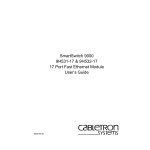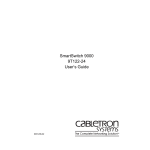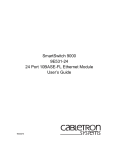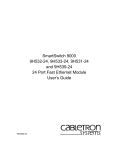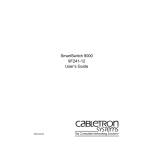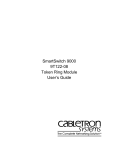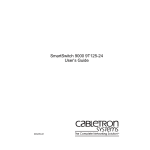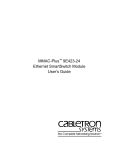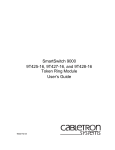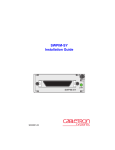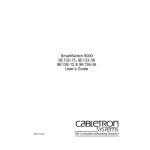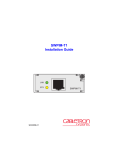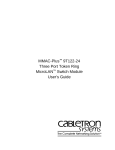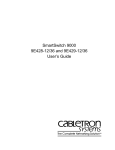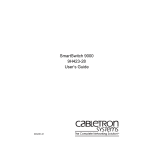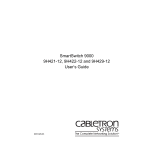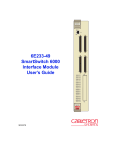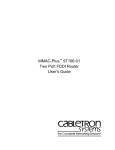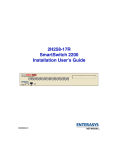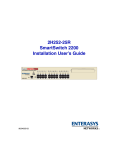Download Enterasys (9H532-18) Networking Switch
Transcript
SmartSwitch 9000 9H531-18 and 9H532-18 18 Port Fast Ethernet Module User’s Guide 9033185-01 Notice NOTICE Cabletron Systems reserves the right to make changes in specifications and other information contained in this document without prior notice. The reader should in all cases consult Cabletron Systems to determine whether any such changes have been made. The hardware, firmware, or software described in this manual is subject to change without notice. IN NO EVENT SHALL CABLETRON SYSTEMS BE LIABLE FOR ANY INCIDENTAL, INDIRECT, SPECIAL, OR CONSEQUENTIAL DAMAGES WHATSOEVER (INCLUDING BUT NOT LIMITED TO LOST PROFITS) ARISING OUT OF OR RELATED TO THIS MANUAL OR THE INFORMATION CONTAINED IN IT, EVEN IF CABLETRON SYSTEMS HAS BEEN ADVISED OF, KNOWN, OR SHOULD HAVE KNOWN, THE POSSIBILITY OF SUCH DAMAGES. 1999 by CABLETRON SYSTEMS, INC., P.O. Box 5005, Rochester, NH 03866-5005 All Rights Reserved Printed in the United States of America Order Number: 9033185-01 August 1999 Cabletron Systems, SPECTRUM, LANVIEW, and MicroMMAC are registered trademarks and SmartSwitch is a trademark of CABLETRON SYSTEMS, INC. All other product names mentioned in this manual may be trademarks or registered trademarks of their respective companies. FCC NOTICE This device complies with Part 15 of the FCC rules. Operation is subject to the following two conditions: (1) this device may not cause harmful interference, and (2) this device must accept any interference received, including interference that may cause undesired operation. NOTE: This equipment has been tested and found to comply with the limits for a Class A digital device, pursuant to Part 15 of the FCC rules. These limits are designed to provide reasonable protection against harmful interference when the equipment is operated in a commercial environment. This equipment uses, generates, and can radiate radio frequency energy and if not installed in accordance with the operator’s manual, may cause harmful interference to radio communications. Operation of this equipment in a residential area is likely to cause interference in which case the user will be required to correct the interference at his own expense. WARNING: Changes or modifications made to this device which are not expressly approved by the party responsible for compliance could void the user’s authority to operate the equipment. INDUSTRY CANADA NOTICE This digital apparatus does not exceed the Class A limits for radio noise emissions from digital apparatus set out in the Radio Interference Regulations of the Canadian Department of Communications. Le présent appareil numérique n’émet pas de bruits radioélectriques dépassant les limites applicables aux appareils numériques de la class A prescrites dans le Règlement sur le brouillage radioélectrique édicté par le ministère des Communications du Canada. VCCI NOTICE This is a Class A product based on the standard of the Voluntary Control Council for Interference by Information Technology Equipment (VCCI). If this equipment is used in a domestic environment, radio disturbance may arise. When such trouble occurs, the user may be required to take corrective actions. i Notice CABLETRON SYSTEMS, INC. PROGRAM LICENSE AGREEMENT IMPORTANT: THIS LICENSE APPLIES FOR USE OF PRODUCT IN THE FOLLOWING GEOGRAPHICAL REGIONS: CANADA MEXICO CENTRAL AMERICA SOUTH AMERICA BEFORE OPENING OR UTILIZING THE ENCLOSED PRODUCT, CAREFULLY READ THIS LICENSE AGREEMENT. This document is an agreement (“Agreement”) between You, the end user, and Cabletron Systems, Inc. (“Cabletron”) that sets forth your rights and obligations with respect to the Cabletron software program (“Program”) in the package. The Program may be contained in firmware, chips or other media. UTILIZING THE ENCLOSED PRODUCT, YOU ARE AGREEING TO BECOME BOUND BY THE TERMS OF THIS AGREEMENT, WHICH INCLUDES THE LICENSE AND THE LIMITATION OF WARRANTY AND DISCLAIMER OF LIABILITY. IF YOU DO NOT AGREE TO THE TERMS OF THIS AGREEMENT, RETURN THE UNOPENED PRODUCT TO CABLETRON OR YOUR DEALER, IF ANY, WITHIN TEN (10) DAYS FOLLOWING THE DATE OF RECEIPT FOR A FULL REFUND. IF YOU HAVE ANY QUESTIONS ABOUT THIS AGREEMENT, CONTACT CABLETRON SYSTEMS (603) 332-9400. Attn: Legal Department. 1. LICENSE. You have the right to use only the one (1) copy of the Program provided in this package subject to the terms and conditions of this License Agreement. You may not copy, reproduce or transmit any part of the Program except as permitted by the Copyright Act of the United States or as authorized in writing by Cabletron. 2. OTHER RESTRICTIONS. You may not reverse engineer, decompile, or disassemble the Program. 3. APPLICABLE LAW. This License Agreement shall be interpreted and governed under the laws and in the state and federal courts of New Hampshire. You accept the personal jurisdiction and venue of the New Hampshire courts. 4. EXPORT REQUIREMENTS. You understand that Cabletron and its Affiliates are subject to regulation by agencies of the U.S. Government, including the U.S. Department of Commerce, which prohibit export or diversion of certain technical products to certain countries, unless a license to export the product is obtained from the U.S. Government or an exception from obtaining such license may be relied upon by the exporting party. If the Program is exported from the United States pursuant to the License Exception CIV under the U.S. Export Administration Regulations, You agree that You are a civil end user of the Program and agree that You will use the Program for civil end uses only and not for military purposes. If the Program is exported from the United States pursuant to the License Exception TSR under the U.S. Export Administration Regulations, in addition to the restriction on transfer set forth in Sections 1 or 2 of this Agreement, You agree not to (i) reexport or release the Program, the source code for the Program or technology to a national of a country in Country Groups D:1 or E:2 (Albania, Armenia, Azerbaijan, Belarus, Bulgaria, Cambodia, Cuba, Estonia, Georgia, Iraq, Kazakhstan, Kyrgyzstan, Laos, Latvia, Libya, Lithuania, Moldova, North Korea, the People’s Republic of China, Romania, Russia, Rwanda, Tajikistan, Turkmenistan, Ukraine, Uzbekistan, Vietnam, or such other countries as may be designated by the United States Government), (ii) export to Country Groups D:1 or E:2 (as defined herein) the direct product of the Program or the technology, if such foreign produced direct product is subject to national security controls as identified on the U.S. Commerce Control List, or (iii) if the direct product of the technology is a complete plant o r any major component of a plant, export to Country Groups D:1 or E:2 the direct product of the plant or a major component thereof, if such foreign produced direct product is subject to national security controls as identified on the U.S. Commerce Control List or is subject to State Department controls under the U.S. Munitions List. 5. UNITED STATES GOVERNMENT RESTRICTED RIGHTS. The enclosed Product (i) was developed solely at private expense; (ii) contains “restricted computer software” submitted with restricted rights in accordance with section 52.227-19 (a) through (d) of the Commercial Computer Software-Restricted Rights Clause and its successors, and (iii) in all respects is proprietary data belonging to Cabletron and/or its suppliers. For Department of Defense units, the Product is considered commercial computer software in accordance with DFARS section 227.7202-3 and its successors, and use, duplication, or disclosure by the Government is subject to restrictions set forth herein. ii Notice 6. EXCLUSION OF WARRANTY. Except as may be specifically provided by Cabletron in writing, Cabletron makes no warranty, expressed or implied, concerning the Program (including its documentation and media). CABLETRON DISCLAIMS ALL WARRANTIES, OTHER THAN THOSE SUPPLIED TO YOU BY CABLETRON IN WRITING, EITHER EXPRESS OR IMPLIED, INCLUDING BUT NOT LIMITED TO IMPLIED WARRANTIES OF MERCHANTABILITY AND FITNESS FOR A PARTICULAR PURPOSE, WITH RESPECT TO THE PROGRAM, THE ACCOMPANYING WRITTEN MATERIALS, AND ANY ACCOMPANYING HARDWARE. 7. NO LIABILITY FOR CONSEQUENTIAL DAMAGES. IN NO EVENT SHALL CABLETRON OR ITS SUPPLIERS BE LIABLE FOR ANY DAMAGES WHATSOEVER (INCLUDING, WITHOUT LIMITATION, DAMAGES FOR LOSS OF BUSINESS, PROFITS, BUSINESS INTERRUPTION, LOSS OF BUSINESS INFORMATION, SPECIAL, INCIDENTAL, CONSEQUENTIAL, OR RELIANCE DAMAGES, OR OTHER LOSS) ARISING OUT OF THE USE OR INABILITY TO USE THIS CABLETRON PRODUCT, EVEN IF CABLETRON HAS BEEN ADVISED OF THE POSSIBILITY OF SUCH DAMAGES. BECAUSE SOME STATES DO NOT ALLOW THE EXCLUSION OR LIMITATION OF LIABILITY FOR CONSEQUENTIAL OR INCIDENTAL DAMAGES, OR IN THE DURATION OR LIMITATION OF IMPLIED WARRANTIES IN SOME INSTANCES, THE ABOVE LIMITATION AND EXCLUSIONS MAY NOT APPLY TO YOU. CABLETRON SYSTEMS SALES AND SERVICE, INC. PROGRAM LICENSE AGREEMENT IMPORTANT: THIS LICENSE APPLIES FOR USE OF PRODUCT IN THE UNITED STATES OF AMERICA AND BY UNITED STATES OF AMERICA GOVERNMENT END USERS. BEFORE OPENING OR UTILIZING THE ENCLOSED PRODUCT, CAREFULLY READ THIS LICENSE AGREEMENT. This document is an agreement (“Agreement”) between You, the end user, and Cabletron Systems Sales and Service, Inc. (“Cabletron”) that sets forth your rights and obligations with respect to the Cabletron software program (“Program”) in the package. The Program may be contained in firmware, chips or other media. UTILIZING THE ENCLOSED PRODUCT, YOU ARE AGREEING TO BECOME BOUND BY THE TERMS OF THIS AGREEMENT, WHICH INCLUDES THE LICENSE AND THE LIMITATION OF WARRANTY AND DISCLAIMER OF LIABILITY. IF YOU DO NOT AGREE TO THE TERMS OF THIS AGREEMENT, RETURN THE UNOPENED PRODUCT TO CABLETRON OR YOUR DEALER, IF ANY, WITHIN TEN (10) DAYS FOLLOWING THE DATE OF RECEIPT FOR A FULL REFUND. IF YOU HAVE ANY QUESTIONS ABOUT THIS AGREEMENT, CONTACT CABLETRON SYSTEMS (603) 332-9400. Attn: Legal Department. 1. LICENSE. You have the right to use only the one (1) copy of the Program provided in this package subject to the terms and conditions of this License Agreement. You may not copy, reproduce or transmit any part of the Program except as permitted by the Copyright Act of the United States or as authorized in writing by Cabletron. 2. OTHER RESTRICTIONS. You may not reverse engineer, decompile, or disassemble the Program. 3. APPLICABLE LAW. This License Agreement shall be interpreted and governed under the laws and in the state and federal courts of New Hampshire. You accept the personal jurisdiction and venue of the New Hampshire courts. 4. EXPORT REQUIREMENTS. You understand that Cabletron and its Affiliates are subject to regulation by agencies of the U.S. Government, including the U.S. Department of Commerce, which prohibit export or diversion of certain technical products to certain countries, unless a license to export the product is obtained from the U.S. Government or an exception from obtaining such license may be relied upon by the exporting party. If the Program is exported from the United States pursuant to the License Exception CIV under the U.S. Export Administration Regulations, You agree that You are a civil end user of the Program and agree that You will use the Program for civil end uses only and not for military purposes. If the Program is exported from the United States pursuant to the License Exception TSR under the U.S. Export Administration Regulations, in addition to the restriction on transfer set forth in Sections 1 or 2 of this Agreement, You agree not to (i) reexport or release the Program, the source code for the Program or technology to a national of a country in Country Groups D:1 or E:2 (Albania, Armenia, Azerbaijan, Belarus, Bulgaria, Cambodia, Cuba, Estonia, Georgia, Iraq, Kazakhstan, Kyrgyzstan, Laos, Latvia, Libya, Lithuania, Moldova, North Korea, the People’s Republic of China, Romania, Russia, Rwanda, Tajikistan, Turkmenistan, Ukraine, Uzbekistan, Vietnam, or such other countries as may be designated by the United States Government), (ii) export to Country Groups D:1 or E:2 (as defined herein) the direct product of the Program or the technology, if such foreign produced direct product is subject to national security controls as identified on the U.S. Commerce Control List, or (iii) if the direct product of the technology is a complete plant o r any major component of a plant, iii Notice export to Country Groups D:1 or E:2 the direct product of the plant or a major component thereof, if such foreign produced direct product is subject to national security controls as identified on the U.S. Commerce Control List or is subject to State Department controls under the U.S. Munitions List. 5. UNITED STATES GOVERNMENT RESTRICTED RIGHTS. The enclosed Product (i) was developed solely at private expense; (ii) contains “restricted computer software” submitted with restricted rights in accordance with section 52.227-19 (a) through (d) of the Commercial Computer Software-Restricted Rights Clause and its successors, and (iii) in all respects is proprietary data belonging to Cabletron and/or its suppliers. For Department of Defense units, the Product is considered commercial computer software in accordance with DFARS section 227.7202-3 and its successors, and use, duplication, or disclosure by the Government is subject to restrictions set forth herein. 6. EXCLUSION OF WARRANTY. Except as may be specifically provided by Cabletron in writing, Cabletron makes no warranty, expressed or implied, concerning the Program (including its documentation and media). CABLETRON DISCLAIMS ALL WARRANTIES, OTHER THAN THOSE SUPPLIED TO YOU BY CABLETRON IN WRITING, EITHER EXPRESS OR IMPLIED, INCLUDING BUT NOT LIMITED TO IMPLIED WARRANTIES OF MERCHANTABILITY AND FITNESS FOR A PARTICULAR PURPOSE, WITH RESPECT TO THE PROGRAM, THE ACCOMPANYING WRITTEN MATERIALS, AND ANY ACCOMPANYING HARDWARE. 7. NO LIABILITY FOR CONSEQUENTIAL DAMAGES. IN NO EVENT SHALL CABLETRON OR ITS SUPPLIERS BE LIABLE FOR ANY DAMAGES WHATSOEVER (INCLUDING, WITHOUT LIMITATION, DAMAGES FOR LOSS OF BUSINESS, PROFITS, BUSINESS INTERRUPTION, LOSS OF BUSINESS INFORMATION, SPECIAL, INCIDENTAL, CONSEQUENTIAL, OR RELIANCE DAMAGES, OR OTHER LOSS) ARISING OUT OF THE USE OR INABILITY TO USE THIS CABLETRON PRODUCT, EVEN IF CABLETRON HAS BEEN ADVISED OF THE POSSIBILITY OF SUCH DAMAGES. BECAUSE SOME STATES DO NOT ALLOW THE EXCLUSION OR LIMITATION OF LIABILITY FOR CONSEQUENTIAL OR INCIDENTAL DAMAGES, OR IN THE DURATION OR LIMITATION OF IMPLIED WARRANTIES IN SOME INSTANCES, THE ABOVE LIMITATION AND EXCLUSIONS MAY NOT APPLY TO YOU. CABLETRON SYSTEMS LIMITED PROGRAM LICENSE AGREEMENT IMPORTANT: THIS LICENSE APPLIES FOR THE USE OF THE PRODUCT IN THE FOLLOWING GEOGRAPHICAL REGIONS: EUROPE MIDDLE EAST AFRICA ASIA AUSTRALIA PACIFIC RIM BEFORE OPENING OR UTILIZING THE ENCLOSED PRODUCT, CAREFULLY READ THIS LICENSE AGREEMENT. This document is an agreement (“Agreement”) between You, the end user, and Cabletron Systems Limited (“Cabletron”) that sets forth your rights and obligations with respect to the Cabletron software program (“Program”) in the package. The Program may be contained in firmware, chips or other media. UTILIZING THE ENCLOSED PRODUCT, YOU ARE AGREEING TO BECOME BOUND BY THE TERMS OF THIS AGREEMENT, WHICH INCLUDES THE LICENSE AND THE LIMITATION OF WARRANTY AND DISCLAIMER OF LIABILITY. IF YOU DO NOT AGREE TO THE TERMS OF THIS AGREEMENT, RETURN THE UNOPENED PRODUCT TO CABLETRON OR YOUR DEALER, IF ANY, WITHIN TEN (10) DAYS FOLLOWING THE DATE OF RECEIPT FOR A FULL REFUND. IF YOU HAVE ANY QUESTIONS ABOUT THIS AGREEMENT, CONTACT CABLETRON SYSTEMS (603) 332-9400. Attn: Legal Department. 1. LICENSE. You have the right to use only the one (1) copy of the Program provided in this package subject to the terms and conditions of this License Agreement. You may not copy, reproduce or transmit any part of the Program except as permitted by the Copyright Act of the United States or as authorized in writing by Cabletron. 2. 3. OTHER RESTRICTIONS. You may not reverse engineer, decompile, or disassemble the Program. APPLICABLE LAW. This License Agreement shall be governed in accordance with English law. The English courts shall have exclusive jurisdiction in the event of any disputes. iv Notice 4. EXPORT REQUIREMENTS. You understand that Cabletron and its Affiliates are subject to regulation by agencies of the U.S. Government, including the U.S. Department of Commerce, which prohibit export or diversion of certain technical products to certain countries, unless a license to export the product is obtained from the U.S. Government or an exception from obtaining such license may be relied upon by the exporting party. If the Program is exported from the United States pursuant to the License Exception CIV under the U.S. Export Administration Regulations, You agree that You are a civil end user of the Program and agree that You will use the Program for civil end uses only and not for military purposes. If the Program is exported from the United States pursuant to the License Exception TSR under the U.S. Export Administration Regulations, in addition to the restriction on transfer set forth in Sections 1 or 2 of this Agreement, You agree not to (i) reexport or release the Program, the source code for the Program or technology to a national of a country in Country Groups D:1 or E:2 (Albania, Armenia, Azerbaijan, Belarus, Bulgaria, Cambodia, Cuba, Estonia, Georgia, Iraq, Kazakhstan, Kyrgyzstan, Laos, Latvia, Libya, Lithuania, Moldova, North Korea, the People’s Republic of China, Romania, Russia, Rwanda, Tajikistan, Turkmenistan, Ukraine, Uzbekistan, Vietnam, or such other countries as may be designated by the United States Government), (ii) export to Country Groups D:1 or E:2 (as defined herein) the direct product of the Program or the technology, if such foreign produced direct product is subject to national security controls as identified on the U.S. Commerce Control List, or (iii) if the direct product of the technology is a complete plant o r any major component of a plant, export to Country Groups D:1 or E:2 the direct product of the plant or a major component thereof, if such foreign produced direct product is subject to national security controls as identified on the U.S. Commerce Control List or is subject to State Department controls under the U.S. Munitions List. 5. UNITED STATES GOVERNMENT RESTRICTED RIGHTS. The enclosed Product (i) was developed solely at private expense; (ii) contains “restricted computer software” submitted with restricted rights in accordance with section 52.227-19 (a) through (d) of the Commercial Computer Software-Restricted Rights Clause and its successors, and (iii) in all respects is proprietary data belonging to Cabletron and/or its suppliers. For Department of Defense units, the Product is considered commercial computer software in accordance with DFARS section 227.7202-3 and its successors, and use, duplication, or disclosure by the Government is subject to restrictions set forth herein. 6. EXCLUSION OF WARRANTY. Except as may be specifically provided by Cabletron in writing, Cabletron makes no warranty, expressed or implied, concerning the Program (including its documentation and media). CABLETRON DISCLAIMS ALL WARRANTIES, OTHER THAN THOSE SUPPLIED TO YOU BY CABLETRON IN WRITING, EITHER EXPRESS OR IMPLIED, INCLUDING BUT NOT LIMITED TO IMPLIED WARRANTIES OF MERCHANTABILITY AND FITNESS FOR A PARTICULAR PURPOSE, WITH RESPECT TO THE PROGRAM, THE ACCOMPANYING WRITTEN MATERIALS, AND ANY ACCOMPANYING HARDWARE. 7. NO LIABILITY FOR CONSEQUENTIAL DAMAGES. IN NO EVENT SHALL CABLETRON OR ITS SUPPLIERS BE LIABLE FOR ANY DAMAGES WHATSOEVER (INCLUDING, WITHOUT LIMITATION, DAMAGES FOR LOSS OF BUSINESS, PROFITS, BUSINESS INTERRUPTION, LOSS OF BUSINESS INFORMATION, SPECIAL, INCIDENTAL, CONSEQUENTIAL, OR RELIANCE DAMAGES, OR OTHER LOSS) ARISING OUT OF THE USE OR INABILITY TO USE THIS CABLETRON PRODUCT, EVEN IF CABLETRON HAS BEEN ADVISED OF THE POSSIBILITY OF SUCH DAMAGES. BECAUSE SOME STATES DO NOT ALLOW THE EXCLUSION OR LIMITATION OF LIABILITY FOR CONSEQUENTIAL OR INCIDENTAL DAMAGES, OR IN THE DURATION OR LIMITATION OF IMPLIED WARRANTIES IN SOME INSTANCES, THE ABOVE LIMITATION AND EXCLUSIONS MAY NOT APPLY TO YOU. v Notice DECLARATION OF CONFORMITY Application of Council Directive(s): Manufacturer’s Name: Manufacturer’s Address: European Representative Name: European Representative Address: Conformance to Directive(s)/Product Standards: Equipment Type/Environment: 89/336/EEC 73/23/EEC Cabletron Systems, Inc. 35 Industrial Way PO Box 5005 Rochester, NH 03867 Mr. J. Solari Cabletron Systems Limited Nexus House, Newbury Business Park London Road, Newbury Berkshire RG13 2PZ, England EC Directive 89/336/EEC EC Directive 73/23/EEC EN 55022 EN 50082-1 EN 60950 Networking Equipment, for use in a Commercial or Light Industrial Environment. We the undersigned, hereby declare, under our sole responsibility, that the equipment packaged with this notice conforms to the above directives. Manufacturer Legal Representative in Europe Mr. Ronald Fotino ___________________________________ Full Name Mr. J. Solari ___________________________________ Full Name Compliance Engineering Manager ___________________________________ Title Managing Director - E.M.E.A. ___________________________________ Title Rochester, NH, USA ___________________________________ Location Newbury, Berkshire, England ___________________________________ Location vi Contents Chapter 1 Introduction Features........................................................................................................................... 1-2 Related Manuals............................................................................................................ 1-7 Getting Help .................................................................................................................. 1-7 Chapter 2 Installing the Module Unpacking the Module................................................................................................. 2-1 User-Accessible Components...................................................................................... 2-1 Using DIP Switch 6 ................................................................................................ 2-4 Installing GPIMs ........................................................................................................... 2-4 Installing the Module in the SmartSwitch 9000 Chassis ......................................... 2-6 The Reset Switch ........................................................................................................... 2-8 Cabling Requirements .................................................................................................. 2-9 10BASE-T Network................................................................................................ 2-9 100BASE-TX Network........................................................................................... 2-9 100BASE-FX Network ........................................................................................... 2-9 1000BASE-SX/1000BASE-LX Network .............................................................. 2-9 Chapter 3 Technical Overview SmartSwitch Architecture ............................................................................................ 3-1 System Management Buses ......................................................................................... 3-3 SMB-1 Bus ............................................................................................................... 3-3 SMB-10 Bus ............................................................................................................. 3-3 System Diagnostic Controller...................................................................................... 3-4 DC/DC Converter ........................................................................................................ 3-4 INB Interface.................................................................................................................. 3-4 i960 Core......................................................................................................................... 3-4 Chapter 4 LANVIEW LEDs Chapter 5 Specifications Technical Specifications................................................................................................ 5-1 CPU .......................................................................................................................... 5-1 Memory ................................................................................................................... 5-1 Network Interfaces ................................................................................................ 5-1 vii Contents Performance ............................................................................................................ 5-1 Regulatory Compliance......................................................................................... 5-2 Service ............................................................................................................................. 5-2 Physical.................................................................................................................... 5-2 Dimensions ...................................................................................................... 5-2 Weight............................................................................................................... 5-2 Environment .................................................................................................... 5-2 Appendix A GPIM Specifications GPIM-01 Specifications (1000Base-SX)......................................................................A-1 GPIM-09 Specifications (1000Base-LX) .....................................................................A-2 Physical and Environmental Specifications .............................................................A-2 Regulatory Compliance...............................................................................................A-3 viii Chapter 1 Introduction The 9H531-18 and 9H532-18 (Figure 1-1) are switching modules for the SmartSwitch 9000. Each module has 18 ports. The 9H531-18 has: • 16 MT-RJ 100 Mbps multimode fiber Ethernet ports • 2 Gigabit Ethernet ports supporting hot-swappable GPIMs of either multimode or single mode fiber The 9H532-18 has: • 16 RJ45 10/100 Mbps Unshielded Twisted Pair (UTP) Ethernet ports • 2 Gigabit Ethernet ports supporting hot-swappable GPIMs of either multimode mode or single mode fiber The 10/100 Ethernet ports can operate in either half or full duplex mode. The Gigabit Ethernet ports operate only in full duplex mode and operate only at 1000 Mbps. Network management information is available through a variety of methods. All information based on Simple Network Management Protocol (SNMP) is accessible either via an in-band (Front Panel port), Side Band (SMB-10), or out-of-band, via the Environmental Module’s COM ports. Serial Line Internet Protocol (SLIP) or Point-to-Point Protocol (PPP) is supported by the Environmental Module’s COM ports. For more information on the SMB-10, SLIP or PPP refer to the SmartSwitch 9000 Local Management User’s Guide. The 9H531-18 and 9H532-18 also feature front panel LANVIEW™ Diagnostic LEDs to offer at-a-glance status information about each front panel port as well as the operation of the overall module. 1-1 Introduction Features Processor The 9H531-18 and 9H532-18 modules are equipped with an advanced Intel i960 microprocessor. This microprocessor provides a platform for all management functions such as Spanning Tree, RMON, and MIB support, within a scalable RISC-Based architecture. Management Management of the 9H531-18 and 9H532-18 modules and SmartSwitch chassis and any optional equipment is accomplished using the Local Management application or remote SNMP management stations. Local Management is accessible through the RS232 COM port on the front panel using a local VT100 terminal, or a remote VT100 terminal via a modem connection, and in-band via a Telnet connection. In-band remote management is possible through any SNMP compliant Network Management Software. Local Management provides the ability to manage the 9H531-18 and 9H532-18. Local Management information for non-Ethernet HSIMs or VHSIMs is included in their respective user’s guide. For details on how to get manuals, refer to the Related Manuals section in the Introduction. WebView The 9H531-18 and 9H532-18 modules can be managed by Cabletron WebView, a browser-based utility. There is no software to install as this management capability is built into each module. For more information see the Cabletron Systems WebView User’s Guide. Connectivity The 9H531-18 and 9H532-18 modules have two interfaces to INB A and B backplanes, and 18 front port connections. The INB interfaces are fixed connections to INB-A and B that allow the modules to communicate with other SmartSwitch 9000 modules supporting various LAN technologies including, Token Ring, FDDI, Ethernet, WAN, Fast Ethernet and ATM. The 9H531-18 is configured with sixteen MT-RJ multimode fiber connectors (compliant with the 802.3u IEEE 100Base-FX specifications) and two Gigabit Uplink Ports. The 9H532-18 is configured with sixteen RJ45 UTP connectors and two Gigabit Uplink Ports. The sixteen RJ45 connectors (compliant with IEEE 802.3u) provide sixteen IEEE 10Base-T/100Base-TX Ethernet ports. The two Gigabit, GPIM connectors (compliant with IEEE 802.3z) provide support for multimode, single mode fiber. GPIMs are not included with the module and are purchased separately. GPIMs are Hot Swappable, i.e., the user can plug a GPIM into the front of the module without taking the module out of the chassis. Currently supported GPIMs include: multimode fiber (GPIM-01) and single mode fiber (GPIM-09). 1-2 Introduction FAST ENET FAST ENET 9H531-18 9H532-18 18 18 17 17 16 16 15 15 14 14 13 13 12 12 11 11 10 10 9 9 8 8 7 7 6 6 5 5 4 4 3 3 2 2 1 1 Figure 1-1. The 9H531-18 and 9H532-18 Module 1-3 Introduction Auto-negotiation The auto-negotiation feature allows the module to automatically use the fastest rate supported by the device at the other end (either 10 Mbps or 100 Mbps at either half or full duplex). To negotiate duplex, the 9H532-18 module and the attached device must be configured for auto-negotiation. If only the 9H532-18 is configured for auto-negotiation, the module will set the connection to half duplex at either the 10 Mbps or 100 Mbps rate. The 9H531-18 supports only 100 Mbps rate. This technology is similar to how modems negotiate transmission speed, finding the highest transmission rate possible. Similarly, auto-negotiation determines the highest common speed between two devices and communicates at that speed. If no common speed is detected, the device will be partitioned. Remote Monitoring (RMON) The 9H531-18 and 9H532-18 support all nine Ethernet RMON groups. The Statistics, Alarms, Events and History groups are enabled on all ports by default. Cabletron Systems RMON Actions is a vendor-specific extension of RMON and provides the ability to set an “Action” on any SNMP MIB variable. The Action can be triggered by setting an RMON Event and/or Alarm. An example of an Action would be to turn off a MIB-2 interface if a broadcast threshold is crossed. Broadcast Suppression Broadcast Suppression enables a user to set a desired limit of receive broadcast frames per port/per second to be forwarded out the other ports on the module up to the set limit. Any broadcast frames above this specified limit are dropped. In the event that broadcast frames are being suppressed, multicast and unicast frames continue to be switched. Port Redirect Function The Port Redirect function, also referred to as “Port Mirroring,” is a troubleshooting tool used to map traffic from a single source port to a destination port within the chassis. This feature allows all packets, including those with errors, to be copied and sent to an analyzer or RMON probe. The analyzer or RMON probe will see the data as if it is directly connected to the LAN segment of the source port. Flow Control Flow Control is a method of managing the flow of frames between two devices. It ensures that a transmitting device does not overwhelm a receiving device with data. This enables the receiving device to communicate with the transmitting device, and to have it pause its transmission while the receiving device processes the frames already received. Flow control can be enabled or disabled on a port-byport basis. Both devices must support the IEEE 802.3x standard for flow control to work. Frame based 802.3x flow control is supported on all Ethernet ports operating in the full duplex mode. 1-4 Introduction 802.1p Port Priority The IEEE 802.1p standard is used to assign a default priority to the frames received without priority information in their tag header, and to map prioritized frames to the appropriate transmit queues. The default priority-to-queue mappings are shown in Table 1-1. This configuration can be changed by the administrator. Table 1-1. Priority Queuing Configuration Priority Indicator Transmit Queue 7 3 6 3 5 2 4 2 3 1 2 0 1 0 0 1 Switching Options The 9H531-18 and 9H532-18 provide IEEE Standard-based 802.1 switching or SecureFast Switching Virtual Network Services. In the 802.1 mode (the default mode of operation), the switch functions as an 802.1D switch. When until VLANs are configured, it operates as an 802.1Q switch. Standards Compatibility The 9H531-18 and 9H532-18 are fully compliant with the IEEE 802.3u, 802.3z, 802.3x, 802.1Q, and 802.1p standards. The 9H531-18 and 9H532-18 provide IEEE 802.1D Spanning Tree Algorithm (STA) support to enhance the overall reliability of the network and protect against “loop” conditions. The 9H531-18 and 9H53218 support a wide variety of industry standard MIBs including RFC 1573 (MIB II), RFC 1271 (RMON), RFC 1493 (Bridge MIB), RFC 1354 (FIB MIB), and RFC 1190 (Path MTU Discovery). A full suite of Cabletron Systems Enterprise MIBs provide a wide array of statistical information to enhance troubleshooting. For information about how to extract and compile individual MIBs, contact Cabletron Systems. 1-5 Introduction GARP Switch Operation Some or all ports on the switch may be activated to operate under the Generic Attribute Registration Protocol (GARP) applications, GARP VLAN Registration Protocol (GVRP) and/or GARP Multicast Registration Protocol (GMRP). GARP is a protocol, or set of rules, that outlines a mechanism for propagating the port state and/or user information throughout a bridged LAN to keep track of users and VLANs on the network fabric. MAC bridges and end users alike can take part in the registration and de-registration of GARP attributes such as VLAN and multicast group membership. Management Information Base (MIB) Support The 9H531-18 and 9H532-18 modules provides MIB support including: • • • RMON (RFC 1271) IETF MIB II (RFC 1573) IETF Bridge MIB (RFC 1493) and a host of other Cabletron Enterprise MIBs. NOTE For a complete list of supported MIBs, refer to the release notes provided with the 9H531-18 and 9H532-18. LANVIEW LEDs The 9H531-18 and 9H532-18 module uses LANVIEW – the Cabletron Systems built-in visual diagnostic and status monitoring system. With LANVIEW LEDs, you can quickly identify, at-a-glance, system status as well as the device, port, and physical layer status. Two LEDs indicate the transmission and reception of data from the INB SmartSwitch 9000 backplane connection. Each of the 18 Ethernet front panel ports features two LEDs per port to indicate the port’s Administrative status (enabled/ disabled), LINK status (Link/Nolink), and Data Activity (receiving and transmitting data). Year 2000 Compliance The 9H531-18 and 9H532-18 module and the SmartSwitch 9000 chassis have an internal clock that can maintain the time and date beyond the year 1999. 1-6 Introduction Related Manuals The Cabletron Systems manuals listed below should be used to supplement the procedures and technical data contained in this manual. SmartSwitch 9000 Installation Guide SmartSwitch 9000 9C300-1 Environmental Module User’s Guide SmartSwitch 9000 9C214-1 AC Power Supply User’s Guide SmartSwitch 9000 9X5XX Series Local Management User’s Guide Cabling Guide Ethernet Technology Guide Network Troubleshooting Guide WebView User’s Guide SmartTrunk User’s Guide Getting Help For additional support related to this device or document, contact the Cabletron Systems Global Call Center: Phone (603) 332-9400 Internet mail [email protected] FTP Login Password ctron.com (134.141.197.25) anonymous your email address Modem setting (603) 335-3358 8N1: 8 data bits, No parity, 1 stop bit BBS For additional information about Cabletron Systems or its products, visit the World Wide Web site: http://www.cabletron.com/ For technical support, select Service and Support. To send comments or suggestions concerning this document, contact the Cabletron Systems Technical Writing Department via the following email address: [email protected] Make sure to include the document Part Number in the email message. Before calling the Cabletron Systems Global Call Center, have the following information ready: • Your Cabletron Systems service contract number • A description of the failure 1-7 Introduction • A description of any action(s) already taken to resolve the problem (e.g., changing mode switches, rebooting the unit, etc.) • The serial and revision numbers of all involved Cabletron Systems products in the network • A description of your network environment (layout, cable type, etc.) • Network load and frame size at the time of trouble (if known) • The device history (i.e., have you returned the device before, is this a recurring problem, etc.) • Any previous Return Material Authorization (RMA) numbers 1-8 Chapter 2 Installing the Module Install the modules by following the steps described later in this chapter. Only qualified personnel should perform installation procedures. Unpacking the Module 1. Carefully remove the module from the shipping box. (Save the box and packing materials in the event the module must be reshipped.) 2. Remove the module from the plastic bag. Observe all precautions to prevent damage from Electrostatic Discharge (ESD). 3. Carefully examine the module, checking for damage. If any damage exists, DO NOT install the module. Contact Cabletron Systems Global Call Center immediately. User-Accessible Components Figure 2-1 shows the various components that can be accessed by users. These consist of an eight-position dip switch (explained in the next section), replaceable PROMs, and sockets for memory and flash upgrades. These can be used for future upgrades. Instructions for installing the components are supplied with the upgrade kits. 2-1 Installing the Module SMB-1 PROM i960 Processor 32mb DRAM Flash SIMM Socket Boot PROM DIP Switch 1 2 3 4 5 6 7 8 Figure 2-1. User-Accessible Components 2-2 Installing the Module The DIP switch on the module (Figure 2-1), is an eight-switch DIP located near the left, bottom corner of the module. Each switch is set according to the functions described in Table 2-1. If switch settings are changed, the processor on the module must be reset, using the reset switch or repowering the module, for changes to take effect. See the Cautions at the end of this table. Table 2-1. Function of DIP Switch Switch Function Description Clear Password-1 This module stores user-entered passwords in NVRAM (Nonvolatile Random Access Memory). To clear these passwords, toggle this switch and then reset the module’s processor. Once the module resets, factory default passwords are placed in NVRAM. You can use these default passwords or, if desired, enter new passwords. To enter new passwords, refer to the Module Local Management User’s Guide. 7 Clear NVRAM-2 This module stores user-entered parameters such as IP addresses, subnet masks, default gateway, default interface, SNMP traps, bridge configurations and module specific configurations in NVRAM. To clear these parameters toggle this switch and then reset the module’s processor. Once the module resets, factory default parameters are placed in NVRAM. You can use the default parameters or, if desired, enter new parameters. To enter new parameters, refer to the Module Local Management User’s Guide. 6 Force BOOTP Download This module uses BOOTP (Boot Strap Protocol) to download new versions of the image file into Flash Memory. This procedure forces image files to be downloaded from the PC or Workstation, configured to act as the BOOTP server, connected to the EPIM port in the Environmental Module. 5 Reserved For Factory Use Only 4 Reserved For Factory Use Only 3 Reserved For Factory Use Only 2 Reserved For Factory Use Only 1 Reserved For Factory Use Only 8 1Caution: ! CAUTION Do not toggle Switch 8 unless you intend to reset the user-configured passwords to the factory default settings. 2Caution: Do not toggle Switch 7 unless you intend to reset the user-entered parameters to the factory default settings. 2-3 Installing the Module Using DIP Switch 6 The purpose of DIP switch 6 is to force a Flash download from a BootP server through the EM-EPIM. The first step in this process is to configure the BootP server. Configurations of BootP servers can differ from platform to platform and from one operating system to another. Read the user’s manual on BootP and TFTP serving for the correct files to edit and the correct files to execute for the server. After configuration of the BootP server the module can then have the switch state changed on dip switch 6 to initiate BootP and TFTP requests. When the state of dip switch 6 is changed, the module begins requesting a BootP server in an attempt to receive a Flash image download. The modules boot PROM initiates a BootP sequence. During this sequence, the module requests an IP address and a filename from the BootP server. The module then requests a TFTP of the file and receives the download of the image. The module will not function until the Flash image is downloaded from the BootP and TFTP server. If a BootP and TFTP are not intended at this time, this process may be stopped by resetting the module. Resetting is done by pushing the reset button on the module, power cycling the chassis, or removing the module from the chassis and re-inserting. (See section titled The Reset Switch on page 2-8.) After resetting, the module again looks for a BootP server, but will time-out after about four minutes. After the time-out the module then boots from Flash memory. The next time the power is cycled, the module will boot from Flash memory and not request the BootP server. Installing GPIMs Two GPIMs may be installed into the module. All GPIMs are installed in the same manner, as listed in this procedure. Refer to Appendix A for cable specifications for the GPIMs. The GPIMs are installed into the SmartSwitch 9000 module as follows: 1. Attach the antistatic strap (refer to the instructions in the antistatic wrist strap package) before removing the GPIM from the antistatic packaging. 2. Remove the GPIM from the packaging. 3. Hold the GPIM with the network connection port facing away from the SmartSwitch 9000 module. The 20-pin connector should be facing towards the empty GPIM slot, with the wide part of the connector oriented up in relation to the printing on the SmartSwitch 9000 module. See Figure 2-2 to orient the GPIM 20-pin connector. 2-4 Installing the Module X R Insertion End X T 20-pin connector Network Connection End 2549_04 Figure 2-2. GPIM 4. Gently insert the GPIM (20-pin connector side) through the GPIM opening of the SmartSwitch 9000 module, as shown in Figure 2-3. The door folds sideways and the slides engage the sides of the GPIM. If the GPIM does not go in easily, do not force the device. Check the orientation against Figure 2-2. Push the GPIM back until the 20-pin port engages the GPIM. The latch mechanism engages when the GPIM connector seats properly in the port. 20-Pin Connector (Insertion End) Locking Tabs RX TX 18 17 Figure 2-3. Installing a GPIM into the SmartSwitch 9000 module To remove a GPIM from the SmartSwitch 9000 module, squeeze both locking tabs in towards the center of the GPIM, and pull it out of the port. 2-5 Installing the Module Installing the Module in the SmartSwitch 9000 Chassis To install the module in the SmartSwitch 9000 chassis, follow the steps below: NOTE The INB Terminator Modules must be installed on the rear of the fourteen slot chassis before powering up this module. The INB Terminator Modules are not required on the six slot chassis. Refer to the INB Terminator Modules Installation Guide for information and installation procedure. 1. Remove the blank panel covering the slot in which the module will be mounted. All other slots must be covered to ensure proper air flow and cooling. 2. Attach one end of the ESD wrist strap (packaged with the SmartSwitch 9000 chassis) to your wrist. Plug the other end into the jack for the ESD wrist strap, located in the lower right corner of the SmartSwitch 9000 chassis shown in Figure 2-4. 3. Slide the module into the slot and lock down both the top and bottom plastic tabs, as shown in Figure 2-4. Take care that the module is between the card guides as shown, it slides in straight, and engages the backplane connectors properly. 2-6 Installing the Module 7 FLNK 8 FLNK FLNK 10 RX FLNK INS TX 11 RX FLNK INS TX 12 RX Jack for ESD wrist strap Metal Back-Panel Circuit Card Card Guides Warning: Ensure that the circuit card is between the card guides. Lock down the top and bottom plastic tabs at the same time, applying even pressure. Figure 2-4. Installing the Module 2-7 Installing the Module The Reset Switch The Reset switch is located on the front panel, under the top plastic tab as shown in Figure 2-5. It serves three functions: resetting the i960 processor, shutting down the module, or restarting the module. • To reset the i960 processor, press the reset switch twice within three seconds. • To shut down the module, press and hold the reset switch down for three or more seconds. • To restart the module after it has been shut down, press and release the Reset Switch. For security, SNMP management can be used to disable the functions of this switch. Reset Switch SMB CPU Figure 2-5. The Reset Switch 2-8 Installing the Module Cabling Requirements 10BASE-T Network When connecting a 10BASE-T segment to the front panel ports of a 9H532-18 module, ensure that the network meets the Ethernet network requirements of the IEEE 802.3 standard for 10BASE-T. If a port is to operate at 100 Mbps, Category 5 cabling must be used. For 10 Mbps operation only, Category 3 cabling can be used. 100BASE-TX Network The 9H532-18 has RJ45 connections that support Category 5 UTP cabling with an impedance between 85 and 111 ohms for 10 and 100 Mbps operation. The device at the other end of the twisted pair segment must meet IEEE 802.3u 100BASE-TX Fast Ethernet network requirements for the devices to operate at 100 Mbps. Refer to the Cabletron Systems Cabling Guide for details. 100BASE-FX Network The 9H531-18 supports 100BASE-FX. When connecting a 100BASE-FX segment to any of the front panel ports, ensure that the network meets the optical performance requirements for 100BASE-FX IEEE 802.3u standard. The 9H531-18 supports multimode fiber cables at the 1300 nm wavelength, at lengths of up to 2 km. 1000BASE-SX/1000BASE-LX Network For information about 1000BASE-SX and 1000BASE-LX, see Appendix A. 2-9 Installing the Module 2-10 Chapter 3 Technical Overview SmartSwitch Architecture The SmartSwitch Architecture of the 9H531-18 and 9H532-18 modules, as shown in Figure 3-1, is configurable for one of two modes of operation: traditional IEEE 802.1 switching, or SecureFast switching. The module supports only one of these modes of operation at any one time. When operating in traditional IEEE 802.1 switch mode, the modules make filtering/forwarding decisions based on Destination Address (DA), with standard IEEE 802.1D learning. 802.1Q VLANs are also supported. Spanning tree operation for the modules is configurable to adhere to IEEE 802.1D, DEC, or none. The default Spanning Tree Algorithm is 802.1D. When operating in SecureFast switch mode, all filtering/forwarding decisions are made on a DA-SA pair and its in and out port on a connection-orientated basis. SecureFast switching mode provides value-added network services including dynamic VLANs, Topology, Connectivity, IP Multicast, Control, Security, Application, Address Management, Dynamic Mapping, and Directory services. For example, Topology Services includes configurable options ranging from simple spanning tree implementations to fully-meshed active topologies. Other services and features supported in SecureFast switching mode are described in detail in the Cabletron White Paper, IP Host Communication in Bridged, Routed and SecureFast Networks. 3-1 Technical Overview SmartSwitch 9000 Backplane DC/DC Converter Gigabit Port i960 Processor Diagnostic Controller Ethernet Controller Gigabit Port INB ASIC Smart Switch Fabric 48 Volt Power Bus SMB 1 SMB 10 A INB ASIC I N B Octal Mac Front Panel Ports (16) B Octal Mac Figure 3-1. Block Diagram 3-2 Technical Overview System Management Buses There are two management channels within the SmartSwitch 9000 system: the SMB-1 and the SMB-10. These buses provide side-band management and intermodule management communication. SMB-1 Bus The SMB-1 is a 1 Mbps management bus located within the SmartSwitch 9000. This bus is utilized by all diagnostic controllers in the system including connectivity modules, power supply modules and the environmental module. The SMB-1 transports inter-chassis information between system components, such as power and environmental information, as well as diagnostic messages. Periodic loop-back tests are performed by all modules that share this bus to ensure the validity of SMB-1. In the event a failure is detected on SMB-1, the SMB10 may be used as an alternate communication channel. SMB-10 Bus The SMB-10 is a 10 Mbps management bus located within the SmartSwitch 9000. This bus is used for inter-chassis communication of modules as well as serving as a side-band management channel into the SmartSwitch 9000. The SMB-10 is externalized from the chassis via an optional Ethernet Port Interface Module (EPIM) located on the front of the Environmental Module. Through an EPIM connection, full-SNMP management of the SmartSwitch 9000 is available side-band from user data. Modules that share the SMB-10 bus periodically send out loop-back packets to ensure the validity of SMB-10. If a fault is detected on the SMB-10, the SMB-1 can be used as an alternate communication channel by the modules. 3-3 Technical Overview System Diagnostic Controller This diagnostic controller is composed of a Z-80 microprocessor and its supporting logic. The diagnostic controller is designed to control the power-up sequencing of modules, monitor the modules’ input and output power parameters, keep watch over the main host processor, monitor the temperature, and control the SMB LANVIEW diagnostic LEDs. Although the system diagnostic controller and the main host processor can operate independently of each other if needed, they exchange information about each other’s status and overall module condition. The information gathered by the diagnostic controller is available to the network manager via local/remote management and the LCD located on the environment module. The modules are designed to continue functioning in the event of a diagnostic controller fault. DC/DC Converter The DC/DC converter converts the 48 VDC on the system power bus to the necessary operating voltages for its host network services module. The diagnostic controller monitors and controls the operation of the DC/DC converter. INB Interface Each module attaches to both INB A and INB B and has two INB ASICs. The INB ASICs use 64 byte Ethernet frames for transmission onto the INBs at 66 MHz. The 9X5XX modules are fully compatible with the the first generation 9X4XX modules. The first generation modules communicate only on INB B using a 56 byte canonical frame format, at 40 MHz. If the newer module detects a first generation module on the backplane, it automatically changes from the fast 66 MHz Ethernet frames, to the first generation compatible 40 MHz canonical frame on INB B only. INB A is used only by the 9X5XX modules and remains at the higher speed. i960 Core The i960 core provides modules host services, the SNMP protocol stacks, to support industry standard MIBs, as well as Cabletron enterprise extension MIBs for each media type. Management services, such as telnet, WebView and network address to MAC address mapping, are also provided by the i960 core. 3-4 Chapter 4 LANVIEW LEDs The front panel LANVIEW LEDs indicate the status of the module and may be used as an aid in troubleshooting. Shown in Figure 4-1 are the LANVIEW LEDs of the 9H531-18 and 9H532-18 modules. FAST ENET 9H532-18 System Status INB Transmit INB Receive 18 GPIM Receive GPIM Transmit 17 LED Mode Switch 16 15 14 Receive (RX) 13 DPX RX SPD TX Transmit (TX) A 12 (Mode Switch in UP Position) 11 10 9 Full Duplex Status 8 7 DPX SPD Speed Status RX TX B 6 (Mode Switch in DOWN Position) 5 4 A LED functions when LED MODE switch is in the RX-TX position. This is the default switch setting. B LED functions when LED MODE switch is in the DPX-SPD position. 3 2 1 Figure 4-1. The LANVIEW LEDs 4-1 LANVIEW LEDs The functions of the two System Status LEDs, System Management Bus (SMB) and CPU (Central Processing Unit), are listed in Table 4-1. Table 4-1. System Status (SMB and CPU) LEDs LED Color State Description Green Functional Fully operational Yellow Testing Power up testing Yellow (Blinking) Crippled Not fully operational (i.e. one port may be bad) Yellow/Green Booting Module is performing its boot process Red Reset Module is resetting Red (Blinking) Failed Fatal error Off Power off Module powered off The functions of the INB Receive LED are listed in Table 4-2. Table 4-2. INB Receive LED LED Color Green State Link, no activity, port enabled Green (Blinking) Link, port disabled Yellow (Flashing) Link, activity, port enabled (Flashing to steady on indicates rate.) Red INB fault, (not synchronized with the Monarch) Off No link, no activity (port enabled) The functions of the INB Transmit LED are listed in Table 4-3. Table 4-3. INB Transmit LED LED Color 4-2 State Green (Flashing) Activity, port enabled (Flashing to steady on indicates rate.) Yellow (Blinking) Port in standby state Red INB fault Off Link (port disabled) LANVIEW LEDs The functions of the Port Receive LEDs are listed in Table 4-4. Table 4-4. Port Receive LEDs LED Color Green State Link, no activity port enabled Green (Blinking) Link, port disabled Yellow (Flashing) Link, activity, port enabled (flashing to steady on indicates rate) Red Fault Off No link, (port disabled) The functions of the Port Transmit LEDs are listed in Table 4-5. Table 4-5. Port Transmit LEDs LED Color State Green (Flashing) Data activity (flashing to steady on indicates rate) Yellow (Blinking) Port in standby state Red (Flashing) Collision (with collision rate) Red Fault Off No activity, port can be disabled or enabled The functions of the GPIM transmit LEDs are listed in Table 4-6. Table 4-6. GPIM Transmit LEDs LED Color State Green (Flashing) Activity, port enabled Yellow (Flashing) Port in standby Red (Flashing) Transmit fault Red Diagnostic failure Off No activity, port enabled 4-3 LANVIEW LEDs The functions of the GPIM receive LEDs are listed in Table 4-7. Table 4-7. GPIM Receive LEDs LED Color State Green Link, no activity. Port enabled Green (Flashing) Link, port disabled Yellow (Flashing) Link, activity. Port enabled Red Diagnostic failure Off No link, no activity. Port enabled or disabled The functions of the Speed and Full Duplex LEDs are list in Table 4-8 and Table 4-9. These LED indications are only valid when the LED MODE switch is in the DPX-SPD position. Table 4-8. DPX Status LEDs (9H532-18 only) LED Color State Green Port is operating in full duplex mode (20 Mbps or 200 Mbps). Yellow Port is in standard (half duplex) mode (10 Mbps or 100 Mbps). Table 4-9. SPD LEDs (9H532-18 only) LED Color 4-4 State Green Port is linked and operating at 100 Mbps. Yellow Port is linked and operating at 10 Mbps. Chapter 5 Specifications Technical Specifications CPU PowerPC Intel i960 RISC based microprocessor Memory 8 MB Flash Memory (expandable to 16 MB) 32 MB DRAM (local) 4 MB Memory (shared) Network Interfaces 16 fixed RJ45 UTP connectors or 16 MT-RJ multimode fiber optic connectors 2 modular Gigabit (GPIM) uplinks Performance Module Switch Fabric bandwidth 3.3 Gbps Module Throughput 2.2 Mpps Source Address Table 16 K entries 5-1 Specifications Regulatory Compliance ! CAUTION It is the responsibility of the person who sells the system to which the module will be a part to ensure that the total system meets allowed limits of conducted and radiated emissions. This equipment meets the following safety and electromagnetic compatibility (EMC) requirements: Safety UL 1950, CSA C22.2 No. 950, EN 60950, IEC 950, and 73/23/EEC Electromagnetic Compatibility (EMC) FCC Part 15, EN 55022, CISPR 22, CSA C108.8, EN 50082-1, AS/NZS 3548, VCCI V-3, and 89/336/EEC Service MTBF (MHBK-217E) MTTR >200,000 hrs. <0.5 hr. Physical Dimensions 35.0 D x 44.0 H x 3.0 W centimeters (13.8 D x 17.4 H x 1.2 W inches) Weight Unit: Shipping: 4.5 kg (10 lb) 5.4 kg (12 lb) Environment Operating Temperature Storage Temperature Relative Humidity 5-2 5 to 40° C (41° to 104°F) -30 to 73° C (-22° to 164°F) 5% to 90% non-condensing Appendix A GPIM Specifications This appendix lists the specifications and regulatory requirements for GPIMs and the media they use. Cabletron Systems reserves the right to change these specifications at any time without notice. The available GPIM options include the GPIM-01 and GPIM-09. The GPIM-01 and GPIM-09 are both fiber optic devices with an SC connector. The GPIM-01 supports multimode (MMF) fiber cable, and the GPIM-09 supports both multimode and single mode (SMF) fiber cable. GPIM-01 Specifications (1000Base-SX) The following specifications for the Gigabit Ethernet GPIMs, listed in Table A-1 though Table A-7, meet or exceed the IEEE 802.3z specification. Table A-1. GPIM-01 Optical Specifications 62.5 µm MMF 50 µm MMF Transmit Power (minimum) -9.5 dBm -9.5 dBm Receive Sensitivity -17 dBm -17 dBm Link Power Budget 7.5 dBm 7.5 dBm Table A-2. GPIM-01 Operating Range Modal Bandwidth @ 850 nm Range 62.5 µm MMF 160 MHz/km 2-220 Meters 62.5 µm MMF 200 MHz/km 2-275 Meters 50 µm MMF 400 MHz/km 2-500 Meters 50 µm MMF 500 MHz/km 2-550 Meters A-1 GPIM Specifications GPIM-09 Specifications (1000Base-LX) Table A-3. GPIM-09 Optical Specifications 62.5 µm MMF 50 µm MMF 10 µm MMF Transmit Power (minimum) -11.5 dBm -11.5 dBm -9.5 dBm Receive Sensitivity -20 dBm -20 dBm -20 dBm Link Power Budget 8.5 dBm 8.5 dBm 10.5 dBm Table A-4. GPIM-09 Operating Range Modal Bandwidth @ 1300 nm A Range 62.5 µm MMF 500 MHz/km 2-550A Meters 50 µm MMF 400 MHz/km 2-550A Meters 50 µm MMF 500 MHz/km 2-550A Meters 10 µm SMF N/A 2-10000 Meters In order to obtain the distance of 550 m for the GPIM-09 using multimode fiber, Launch Mode Conditioning cable must be used. Physical and Environmental Specifications Table A-5. GPIM Physical Properties Dimensions 1.2 H x 3.4 W x 6.5 D (cm) 0.47 H x 1.34 W x 2.56 D (in) Weight 25 g (0.88 oz) Table A-6. GPIM Environmental Requirements A-2 Operating Temperature 5°C to 40°C (41°F to 104°F) Storage Temperature -30°C to 90°C (-22°F to 194°F) Operating Humidity 5% to 90% (non-condensing) Regulatory Compliance Regulatory Compliance The GPIMs meet the following safety and electromagnetic compatibility (EMC) requirements: Table A-7. Regulatory Compliance Eye Safety (fiber GPIMs only) FDA CDRH 21-CFR 1040 Class 1, IEC 825 Issue 1 1993:11 Class 1, CENELEC EN 60825 Class 1 A-3 GPIM Specifications A-4










































